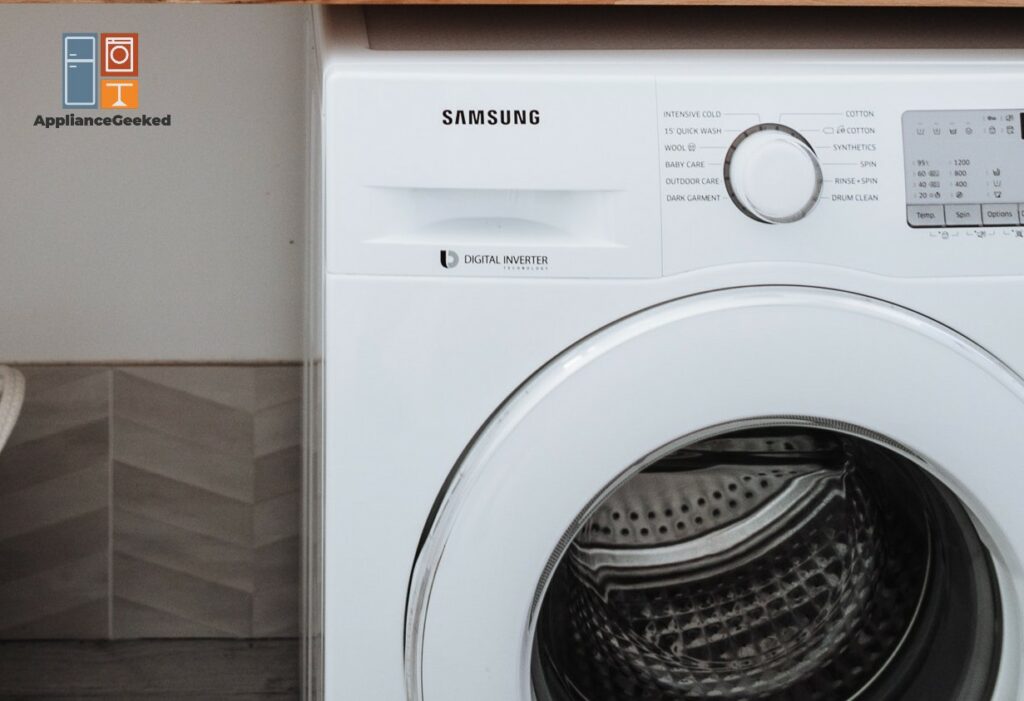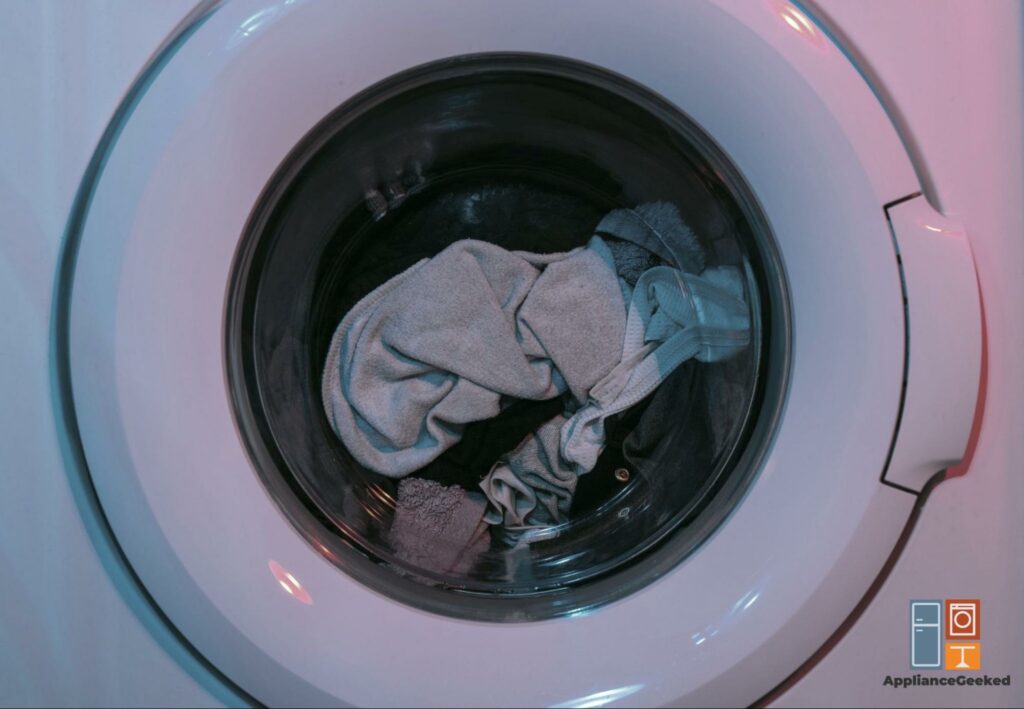
Do you measure your detergent when you do the laundry? Like so many others, we once thought that more suds meant more cleaning power.
However, it’s quite the opposite.
Your washer struggles to clean your clothes thoroughly if you tend to pour generous amounts of detergent. It may even result in a SUD error code, which stops the cycle until the excess foam dissipates.
Here, we’re going to delve into the causes of the SUD error code on Samsung washers. We will also show you how to fix the problem and prevent it from happening again.
What does the SUD error code on my Samsung washer mean?
A SUD error code appears on your Samsung washing machine when it detects an excessive amount of soap suds in the drum.
It means you’re either using the wrong type of detergent or you’re using too much detergent.
Depending on your Samsung washer model, the SUD error may appear as 5UD, Sd, 5d, SUdS, or 5UD5.
Wrong Detergent
Most modern Samsung washers are labeled as high-efficiency (HE). Compared to traditional washers, HE models use low water levels and gentle rotating motions to clean your laundry.
Due to this, you can’t use regular laundry detergent on your HE washer. If you do, it will fill your tub with an excessive amount of suds, triggering an error code.
Instead, you must use an HE detergent, which is formulated with low-sudsing properties. Whether you have a front-load or top-load HE model, you must use HE detergent instead of the regular kind to prevent excess foam.
Although Samsung doesn’t have specific brand recommendations, it strongly discourages using laundry detergents with natural ingredients, such as vinegar and baking soda. According to the manufacturer, these products may damage your washer.
Too Much Detergent
One of the tell-tale signs that you’re using too much detergent is when your laundry has a slimy chalky coating after your cycle. That means your washer was unable to rinse away the excess detergent, leaving residue on your clothes.
As mentioned, using too much detergent can also lead to excess foam. As that foam starts to build up inside the tub, you’ll notice your Samsung washer occasionally stopping.
Your washer will stop and wait for the suds to dissipate before continuing the cycle. Since the foam interferes with the tumbling action inside the tub, it prevents your clothes from getting clean.
If you usually pour heaping amounts of detergent, it’s time to stop this laundry practice because it has no benefits at all.
Aside from ending up with slimy laundry, detergent residue can accumulate inside your tub, making your washer smell like sewage(Samsung top load washer smells like sewer) or mold.
How to Fix a SUD Error on a Samsung Washer
To resolve a SUD error on a Samsung washer, wait for the excess suds to settle. If the cycle stopped, it will automatically continue once the foam dissipates.
If it doesn’t continue, run a spin cycle and clean your clothes without detergent. Then, run a Self-Clean cycle to clear detergent residue.
Clean up the excess suds.
Sometimes, if the washer detects too much foam in the tub, it will automatically stop the cycle. At this point, all you have to do is wait for the suds to dissipate and hope that the cycle continues.
If, after a considerable amount of time, your washer still hasn’t continued the cycle, you must take matters into your own hands. You can’t leave the wet laundry in your tub or else it will start to smell.
Solution: To remove the excess suds in your Samsung washer, follow these steps:
- Step 1: Wait for the suds to settle in your washer.
- Step 2: Run a spin cycle.
- Step 3: Wash the laundry without detergent.
- Step 4: Take the clothes out of the washer if it no longer has the slimy and chalky film. Then, put them in the dryer or hang them out to dry.
- Step 5: Run a Self-Clean cycle or manually clean your drum.
- Step 6: Clean the detergent drawers.
Clean up the detergent drawers.
After washing away the foam and detergent residue in the tub, start cleaning the detergent drawers. You don’t want residue to build up inside the drawer because it can also cause more suds.
Moreover, the residue may cause mold growth and all sorts of funky smells that can transfer to your clothes during cycles. Ideally, you should clean the drawer every five to ten washes.
Solution: To clear residue build-up in your detergent drawer, follow these steps:
- Step 1: Pull the detergent drawer all the way out.
- Step 2: Carefully lift the drawer up to remove it.
- Step 3: Rinse the drawer in warm water. Then, use a soft brush to remove any detergent residue.
- Step 4: Scrub the drawer opening using a soft cloth or non-metallic brush.
- Step 5: Wipe the opening with a dry cloth.
- Step 6: Align the drawer with the rails and gently push it back in.
Clean the debris filter.
If cleaning the tub and the detergent drawer doesn’t resolve the SUD error, you should give your debris filter a good scrub. Only front-load washers have a debris filter, so this fix doesn’t apply to top-load models.
The debris filter must be cleaned every 30 to 40 loads to maintain the efficiency of your washer and to prevent unpleasant odors from developing. Depending on your usage, it means you should clean it once every two or three months.
Obstructions can prevent the debris filter from draining properly, which can cause excess suds and strange smells.
Solution: To clean a debris filter on a Samsung washer, follow these steps:
- Step 1: Turn off the washer, and unplug its cord.
- Step 2: Place a towel to protect your floors from water damage.
- Step 3: Open the debris filter cover.
- Step 4: Grab the drain hose and remove its cap to drain excess water into a bowl. Or, use the auto drain feature in your washer.
- Step 5: Reinstall the cap and push the hose back in after the water stops draining.
- Step 6: Rotate the debris filter counterclockwise and pull it out to remove it.
- Step 7: Remove any blockages (e.g. coins, clips, and buttons).
- Step 8: Clean the filter with a soft brush and rinse it under running water.
- Step 9: Reinstall the filter into the housing and rotate it clockwise.
- Step 10: Close the cover.
Use the right kind and the right amount of detergent.

To prevent a SUD error code from recurring, you must use the correct kind of detergent and the right amount for your laundry load.
If you own an HE washer, you must only use an HE detergent. It doesn’t matter if it’s liquid or powdered detergent.
| Tips: • If you are unsatisfied with the cleaning performance of the detergent, try switching to a different product instead of adding more to the dispenser. • Powdered detergent doesn’t dissolve as easily as a liquid detergent in cold water. • Liquid detergent can be used for pre-soaking heavily stained clothes. |
Since HE detergents are very concentrated, you don’t need to pour too much into the drawer. You shouldn’t go over the max level on your detergent drawer.
If the brand’s recommendation exceeds the max line, you should reduce the size of the load instead of going over the level. Or, you can switch to a more concentrated formula.
So, how much detergent do you need?
| HE Detergent | Standard Washer | HE Washer |
| 2x Liquid Detergent | 2 tablespoons | 2 teaspoons |
| Powder Detergent | ¼ cup | 2 tablespoons |
| Laundry Pods | 1 per cycle | 1 per cycle |
Some Samsung washers have an auto-dispensing system, which measures the liquid laundry detergent for you.
Solution: To use the auto dispenser on your Samsung washer, follow these steps:
- Step 1: Open the detergent drawer.
- Step 2: Rotate the compartment cover counterclockwise to open it.
- Step 3: Pour the liquid detergent and softener into their respective compartments.
- Step 4: Push the drawer in until you hear a click.
- Step 5: Click on Options and turn the dial to Dose per Wash to adjust the settings of your auto-dispenser.
- Step 6: Tap OK, and select the ideal amount of detergent you want to be dispensed automatically.
Frequently Asked Questions
You can use high-efficiency detergent in a regular washer, but you can’t use regular detergent in an HE washer. That’s because it will result in an excessive amount of suds, which can cause leaks, mold, and unpleasant odors.
Using regular detergent in an HE washer can also trigger the SUDS error code. It will stop the cycle until the foam clears inside the drum.
Your Samsung washer will automatically stop the cycle when it detects an excessive amount of suds in the drum. After 10 minutes or so, when the foam has dissipated, it will continue the cycle.
However, this isn’t always the case. You might have to run a Self-Clean cycle to manually clear the suds and the detergent residue in the tub, which might take an hour on a top-load washer and about four hours on a front-load model.
You only need about two tablespoons of liquid detergent on a standard washer and around two teaspoons on an HE washer. That is more than enough to clean normal to large-sized laundry loads.



